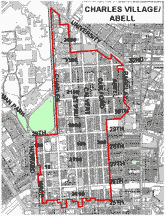Charles Village/Abell
National Register of Historic Places 12/15/83
Certified Historic District for Tax Incentives (NR)
 Description
Description
Charles Village/Abell is a distinctive, well defined area in North Central Baltimore City. It is generally bounded by 25th Street on the south; Mace Street and Charles Street on the west; University Parkway on the north; and Barclay Street and Guilford Avenue on the east. The district takes in some forty-five-city blocks and consists of approximately 1500 structures. This overwhelmingly residential district is primarily made up of circa 1895-1915 rowhousing built along a strict grid pattern. The houses were built primarily in large groups often taking up entire city blocks.
There is a variety of housing types featuring eclectic architectural elements such as pediments front porches, bowed fronts, projecting bays, dutch gables, pyramidal and conical roofs, small balconies, and stained glass windows and transoms. Most of the housing is set back from the street providing well landscaped front lawns that are compatible to the park like boulevards of North Charles Street and Thirty third Street. In addition to the rowhousing, many early twentieth century apartment buildings are located within the district. Other building types in the area include churches, individual houses, institutional structures and a few compatible commercial buildings. The district is characterized by its strong north-south emphasis, largely residential character, distinctive housing set back from the street and a high degree of integrity that distinguishes Charles Village/Abell from surrounding neighborhoods located along diverging street patterns.
Significance
The Charles Villages/Abell area has played an important role in the development of North Central Baltimore. It can be considered the northernmost extension of Baltimore's finest rowhouse neighborhoods which first developed at Mount Vernon Place and expanded northward along the Charles Street corridor. The architecture of Charles Village/Abell represents a cross section of late nineteenth to early twentieth century rowhousing, individual homes, apartments, institutional structures and compatible commercial buildings that provide the pivotal transition between the heavily urbanized neighborhoods to the south and the garden suburbs of Guilford, Homeland and Roland Park to the north.
This area is unique since it combines and urban grid street pattern and rowhouse character with suburban like landscaped front yards and park like boulevards; the result of early community planning efforts. Both the predominance of eclectic rowhouse detailing which represents a complete break from the traditional Baltimore rowhouse and the area's high degree of integrity with few intrusions and alterations distinguishes Charles Village/Abell from other Baltimore neighborhoods. The development of this area is associated with important developer/builders who shaped the growth of many and national architects responsible for the area's design excellence. The early residents of the neighborhood included many important Baltimore Civic and business leaders.
 Description
Description